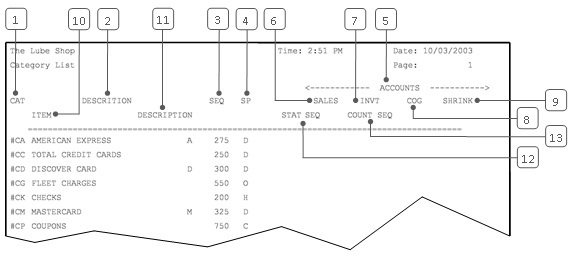The detailed Category List shows how each item and category is set up in your system. Information on categories includes the following:
All the inventory items are shown within each category on the detailed report. For individual items, you can see these sequence numbers:
All this information is used to define inventory items and categories for system calculations. For example, this setup determines which items are included in each category for statistics purposes.
Use the following steps to print a Category List:
| Field | Definition | ||
|---|---|---|---|
| Print Time on Report | Printing the time helps you identify the most current report when the same report is printed more than once during a day. This field defaults to Y to print the time on the report. If you do not want the time to print on a report, type N. We recommend that you always print the time on a report. | ||
| Summary Only | This field appears for reports with both detailed and summary versions. Enter N to print the detailed report. We recommend printing a detailed report only if you need detailed information. | ||
| Duplex | This field appears for terminals that have report type 2 enabled in the Set Up Printer Controls screen. Duplex mode enables printing on both sides of the paper.
|
||
| Landscape | This field appears for terminals that have report type 2 enabled in the Set Up Printer Controls screen. It prints horizontally on the paper. | ||
| Number of Printed Lines per Page | This value tells the computer how many lines to print on each page of the report. A typical 11-inch page can contain up to 66 lines, but this field defaults to 60 to allow three-line margins at the top and bottom of the page.
|
||
| Total Number of Lines per Page | This field indicates the length of the paper in the printer. A typical 11-inch page contains 66 lines. Your system interprets a 0 or 66 in this field to mean that standard 11-inch paper is loaded in the printer. Because a 66 causes a form feed to take more time, accepting the default, 0, is recommended. | ||
| Print Report To | This field tells the computer where to send the report. The following list contains the different selections available for this field.
|
||
| Command Line Options | The line at the bottom of the screen contains commands to print the report and to save or change the report settings.
|

| Callout | Item | Description | ||
|---|---|---|---|---|
| 1 | CAT | Category of the inventory item. | ||
| 2 | Description | Category description. | ||
| 3 | Seq | Sequence. This is the statistics sequence number, which determines where the category is included on statistics reports. | ||
| 4 | SP | Special type. A code here indicates a special non-inventory category. For example, S represents ticket sales and D represents credit cards. | ||
| 5 | Accounts | Account numbers, which show how the categories interface with accounting files. Each category has an account number for each of the four account types. | ||
| 6 | Sales | The income account that is updated when the category of items produces revenue. | ||
| 7 | Invt | Inventory. The asset account that includes the value of the on-hand items in this category. | ||
| 8 | COG | Cost of goods. When an item is sold, the cost of that item is removed from inventory, becomes an expense and is added to this account. | ||
| 9 | Shrink | Shrinkage. Any adjustments made to items in the category affect this account and offset the inventory account.
|
||
| 10 | Item | Number of the inventory item within the category. | ||
| 11 | Description | Description of the inventory item. | ||
| 12 | Stat Seq | Statistics sequence number. This number exists for those items not in special categories. This number determines where an individual item is included on statistics reports. Since most items are not included individually, this number is usually zero. | ||
| 13 | Count Seq | Count sequence number, for items not in special categories. Indicates where the item prints on the count sheets. A 0 in this column means the item does not appear on the count sheets. Only physical inventory items should have a non-zero count sequence number. |
This report helps you verify that items and categories are set up properly in your system. This is important to ensure that information is sent to the correct accounting and statistics functions. Look carefully at the category information to verify the account numbers, special types, and sequence numbers. Also check each item to make sure that it is included in the appropriate category. You should run this report during initial store setup and whenever you make changes to your accounting or inventory setup.
Another report that shows items by category is the Inventory by Category List. The Statistics Sequence List prints sequence numbers for categories and individual items in sequence order.